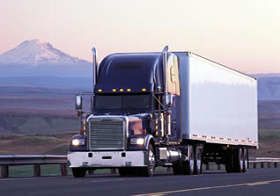Backing Tips
Topic 32297 | Page 4

How does the 6ft help on the initial setup ? I was taught to hug the side with tandems all the way forward . I wonder if that’s why I have had issues at truck stops .
Tandems:
Tandem Axles
A set of axles spaced close together, legally defined as more than 40 and less than 96 inches apart by the USDOT. Drivers tend to refer to the tandem axles on their trailer as just "tandems". You might hear a driver say, "I'm 400 pounds overweight on my tandems", referring to his trailer tandems, not his tractor tandems. Tractor tandems are generally just referred to as "drives" which is short for "drive axles".
Tandem:
Tandem Axles
A set of axles spaced close together, legally defined as more than 40 and less than 96 inches apart by the USDOT. Drivers tend to refer to the tandem axles on their trailer as just "tandems". You might hear a driver say, "I'm 400 pounds overweight on my tandems", referring to his trailer tandems, not his tractor tandems. Tractor tandems are generally just referred to as "drives" which is short for "drive axles".
It's possible. A lot of learning your setup is trial and error.
How does the 6ft help on the initial setup ? I was taught to hug the side with tandems all the way forward . I wonder if that’s why I have had issues at truck stops .
Tandems:
Tandem Axles
A set of axles spaced close together, legally defined as more than 40 and less than 96 inches apart by the USDOT. Drivers tend to refer to the tandem axles on their trailer as just "tandems". You might hear a driver say, "I'm 400 pounds overweight on my tandems", referring to his trailer tandems, not his tractor tandems. Tractor tandems are generally just referred to as "drives" which is short for "drive axles".
Tandem:
Tandem Axles
A set of axles spaced close together, legally defined as more than 40 and less than 96 inches apart by the USDOT. Drivers tend to refer to the tandem axles on their trailer as just "tandems". You might hear a driver say, "I'm 400 pounds overweight on my tandems", referring to his trailer tandems, not his tractor tandems. Tractor tandems are generally just referred to as "drives" which is short for "drive axles".
New Reply:
New! Check out our help videos for a better understanding of our forum features

















Preview:
This topic has the following tags:
Advice For New Truck Drivers Backing Challenges Becoming A Truck Driver Tips For Backing







 TT On Facebook
TT On Facebook
Tons of good advice. I check satellite images and steet view like a person with ocd in a home full of crooked hanging pictures. Also like G town said, I do it by feel most of the time, I just sort of developed a feel for the arc it's going to take. I know for a long time I obsessed on setup and looking for a reputable pattern of movement but eventually found that the concept is the same but it's kind of a zen thing for me.
Also, I rarely make big sweeping movements of the wheel anymore.
I prefer the tandems in the middle to back but honestly don't care that much. Some places have me move them all the way back, some I have at the 40, others, wherever it scaled out to even weights. But I practice backing with them in different locations.
Also, at Sam's and Lowes, it's nit uncommon for me to have to dock and move 4 or 5 trailers which gets you plenty of practice.
If you want a super tight place in Denver, the PCA DC is a nightmare. Mostly blindside too.
Tandems:
Tandem Axles
A set of axles spaced close together, legally defined as more than 40 and less than 96 inches apart by the USDOT. Drivers tend to refer to the tandem axles on their trailer as just "tandems". You might hear a driver say, "I'm 400 pounds overweight on my tandems", referring to his trailer tandems, not his tractor tandems. Tractor tandems are generally just referred to as "drives" which is short for "drive axles".
Tandem:
Tandem Axles
A set of axles spaced close together, legally defined as more than 40 and less than 96 inches apart by the USDOT. Drivers tend to refer to the tandem axles on their trailer as just "tandems". You might hear a driver say, "I'm 400 pounds overweight on my tandems", referring to his trailer tandems, not his tractor tandems. Tractor tandems are generally just referred to as "drives" which is short for "drive axles".
EPU:
Electric Auxiliary Power Units
Electric APUs have started gaining acceptance. These electric APUs use battery packs instead of the diesel engine on traditional APUs as a source of power. The APU's battery pack is charged when the truck is in motion. When the truck is idle, the stored energy in the battery pack is then used to power an air conditioner, heater, and other devices